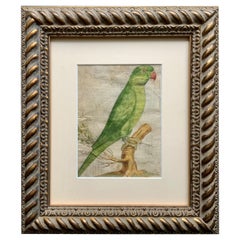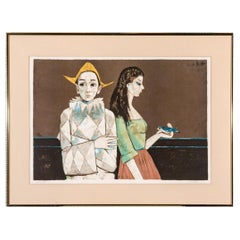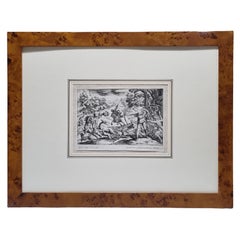Eduardo Ramirez Villamizar Furniture
1
to
1
1
1
1
1
1
1
1
1
5,229
4,014
2,455
2,235
Creator: Eduardo Ramirez Villamizar
1622 Antonio Tempesta; Fr. Villamena Parakeet Parrochetto Pasta
By Eduardo Ramirez Villamizar
Located in Norwich, GB
PARROCHETTO Budgerigar Parakeet
Verso with recipe for Parakeet and Pasta!!
Extremely rare
Copper engraving published by Giovanni Pietro Olina (1585-1645) for his scarce treatise:
Uccelliera overo discorso della natura e proprieta di diversi uccelli.
Rome: Andrea Fei, 1622.
Uccelliera is a discourse on the characteristics of the many birds to be found in Italy, and gives instructions on their care, and identifies their habits and songs.
Antonio Tempesta, also called il Tempestino (1555 – 5 August 1630), was an Italian painter and engraver, whose art acted as a point of connection between Baroque Rome and the culture of Antwerp.
Francesco Villamena was an Italian engraver and artist. Villamena was born in Assisi. He studied under Cornelis Cort...
Category
1620s Italian Renaissance Antique Eduardo Ramirez Villamizar Furniture
Materials
Paper
Related Items
Charles Levier (Fr., 1920 - 2003) Large Lithograph Harlequin & Woman With Bird
By Charles Levier
Located in Bridgeport, CT
Lithograph depicting a harlequin standing shoulder to shoulder with a woman holding a blue bird in her hand.
Limited edition of 250 lower left.
Signed lower right.
Presented in a gol...
Category
Mid-20th Century French Mid-Century Modern Eduardo Ramirez Villamizar Furniture
Materials
Metal
H 28 in W 36.38 in D 1 in
17th Century "Diana's Deer and Boar Hunt" Etching by Antonio Tempesta
By Antonio Tempesta
Located in Cagliari, IT
A fine mythological etching by the great Italian engraver Antonio Tempesta (Florence, 1555 – Rome, 5 August 1630) printed by François L'Anglois or Langlois (12 May 1589 (baptised) – 13 January 1647),also called F. L. D. Ciartres (" Francois Langlois from Chartres"). Beautiful sheet , very sharp .
The dimensions below are inclusive of the frame, the print without the frame measures 27x19 cm
Antonio Tempesta, also called il Tempestino (1555 – 5 August 1630), was an Italian painter and engraver, whose art acted as a point of connection between Baroque Rome and the culture of Antwerp. Much of his work depicts major battles and historical figures.
He was born and trained in Florence and painted in a variety of styles, influenced to some degree by "Counter-Maniera" or Counter-Mannerism. He enrolled in the Florentine Accademia delle Arti del Disegno in 1576. He was a pupil of Santi di Tito, then of the Flemish painter Joannes Stradanus. He was part of the large team of artists working under Giorgio Vasari on the interior decoration of the Palazzo Vecchio in Florence.
His favourite subjects were battles, cavalcades, and processions. He relocated to Rome, where he associated with artists from the Habsburg Netherlands, which may have led to his facility with landscape painting.
Among his followers was Marzio di Colantonio.
Tempesta and the Flemish painter Matthijs Bril were commissioned by Pope Gregory XIII to paint wide panoramas of the Procession to Transfer the Relics of St. Gregory of Nazianzus (1572) for the loggias on the third floor of the Vatican Palace. He completed frescoes in the Palazzina Gambara at the Villa Lante in Bagnaia (1578-1609). From 1579–83, Tempesta participated in the decoration of the Villa Farnese in Caprarola, notably of this villa's Scala Regia. He is also known to have collaborated on frescoes in the Villa d'Este at Tivoli and the Palazzina Gamara at Villa Lante, Bagnaia. He painted a series of turbulent and crowded battle scenes for the Medici. He also completed a series of engravings on outdoor courtly hunting scenes.
Tempesta painted frescoes for the Palazzos Colonna, the Doria Pamphilj, and for the Marchese Giustiniani in his Roman palace, where Tempesta collaborated with Paul Bril, and at Bassano di Sutri. He painted a Massacre of the Innocents for the church of Santo Stefano Rotondo in Rome.
Tempesta is now best known as a printmaker in etching and engraving. He also left numerous etchings, among them: Plates from the Old Testament; twenty-four plates from the Life of St. Anthony; a set of 150 prints from Ovid’s Metamorphoses; 13 plates on The Labours of Hercules and four plates on respectively The ages of man; The entry of Alexander into Babylon; Diana and Actaon, and The crucifixion (1612).
In 1612 he engraved a series of plates under the title "Batavorum cum Romanis Bellum" after designs of the Netherlandish artist Otto van Veen, also known as Vaenius (1556-1629) and court painter to Alessandro Farnese. Van Veen was influenced by the Italian mannerists but had developed his own style anticipating the Flemish baroque of his pupil Peter Paul Rubens. The series consists of 36 numbered engraved plates and illustrates the armed struggle between the ancient Dutch tribes and their Roman oppressors as narrated in Tacitus' Histories. Each plate bears at the bottom an engraved legend in Flemish and in Latin while a detailed explanation is printed on the otherwise blank verso. Plate I, signed 'Ant.Tempesta f. Anno 1611', shows 'Roma' and 'Batavia' in battle dress with respective scenic backgrounds, symbolizing the two nations. Fifteen other plates bear Tempesta's monogram. The plates depict heroic events, sieges, and battle scenes. This historicist work was very popular in its time.
Tempesta also drew many designs for tapestries.
François L’Anglois or Langlois (12 May 1589 (baptised) – 13 January 1647), also called F. L. D. Ciartres ("François Langlois from Chartres"), was a French print publisher, print seller, engraver, bookseller, art dealer, and painter. He is widely considered to have been the first important print publisher in France and to have contributed significantly to spreading awareness of contemporary artists' work throughout Europe.
François L’Anglois was born in Chartres and baptised there on 12 May 1589. He visited Italy on several occasions: Rome in 1613 and 1614 and Genoa, Florence, and Rome again in 1621. On these trips he met Anthony van Dyck and Claude Vignon, who both painted his portrait. He also became acquainted with the engravers Stefano della Bella and François Collignon. It was probably around this time that he acquired the nickname of Chartres (Ciartres in Italian). In 1624–1625 he was associated with Vignon as an art dealer (paintings) and acted as a print collector for Thomas Howard, 14th Earl of Arundel, and Charles I of England...
Category
17th Century French Baroque Antique Eduardo Ramirez Villamizar Furniture
Materials
Paper
Original Barcelona 1992 Olympic Poster by Antonio Saura for the XXV Olympiad
By Antonio Saura
Located in London, GB
He began painting and writing in 1947 in Madrid while suffering from tuberculosis, having already been confined to his bed for five years. In his beginnings he created numerous drawings and paintings with a dreamlike surrealist character that most often represented imaginary landscapes, employing a flat smooth treatment that offers a rich palette of colors. He claimed Hans Arp and Yves Tanguy as his artistic influences.
He stayed in Paris in 1952 and in 1954–1955 during which he met Benjamin Péret and associated with the Surrealists, although he soon parted with the group, joining instead the company of his friend the painter Simon Hantaï. Using the technique of scraping, he adopted a gestural style and created an abstract type of painting, still very colorful with an organic, aleatory design.
The first appearances in his work of forms that will soon become archetypes of the female body or the human figure occur in the mid-1950s. Starting in 1956 Saura tackled the register of what will prove to be his greatest works: women, nudes, self-portraits, shrouds and crucifixions, which he painted on both canvas and paper. In 1957 in Madrid he founded the El Paso Group and served as its director until it broke up in 1960. During this period Saura met Michel Tapié.
During the 1950s he had his first solo exhibition at the Rodolphe Stadler Gallery in Paris, where he regularly exhibited throughout his life. Stadler introduced him to Otto van de Loo in Munich and Pierre Matisse in New York City, both of whom exhibited his work and represented him, and eventually his paintings were collected by major museums.
Limiting his palette to blacks, grays and browns, Saura asserted a personal style that was independent of the movements and trends of his generation. His work followed in the tradition of Velasquez and Goya. Starting in 1959 he began creating a prolific body of works in print, illustrating numerous books including Cervantes's Don Quijote, Orwell's Nineteen Eighty-Four, Nöstlinger's adaptation of Pinocchio, Kafka’s Tagebücher, Quevedo’s Three Visions, and many others.
In 1960 Saura began creating sculptures made of welded metal elements which represented the human figure, characters and crucifixions. In 1967 he settled permanently in Paris, and joined the opposition to Francoist Spain. In France he participated in numerous debates and controversies in the fields of politics, aesthetics and artistic creation. He also broadened his thematic and pictorial register. Along with his Femmefauteuil (literally "Womanarmchair"), he also worked on the series "Imaginary Portraits",and Goya’s Dog...
Category
1990s Spanish Modern Eduardo Ramirez Villamizar Furniture
Materials
Paper
H 0.04 in W 27.56 in D 19.69 in
Framed Etching of Vases by Giovanni Piranesi
Located in Bradenton, FL
The dramatic large, almost 4 foot tall etching is framed with a green ground and gold double border with cream French matting. Copper-plate engraving by Italian artist Giovanni Piran...
Category
19th Century Italian Renaissance Antique Eduardo Ramirez Villamizar Furniture
Materials
Paper
Hand Colored Antique Bird Print of a Sun Parakeet
Located in Langweer, NL
Antique bird print titled 'Solstitial Parrakeet. Hand colored print of a sun parakeet. This print originates from 'Systematic Natural History'. Printed for G. Kearsley, 1800-1826.
Category
Early 19th Century Antique Eduardo Ramirez Villamizar Furniture
Materials
Paper
LIFE OF SAINT JOHN AND THE APOCALYPSE - One-time only limited-edition facsimile
Located in BARCELONA, ES
This is a one-time only facsimile edition limited to 987 copies of an illuminated manuscript from the Middle Ages, the Life of Saint John and the Apocalypse, owned by the British Lib...
Category
2010s Dutch Renaissance Eduardo Ramirez Villamizar Furniture
Materials
Metal
Free Shipping
H 12.6 in W 7.88 in D 1.58 in
Antique Bird Print of the Beautiful Parakeet, Swift Parrot, circa 1880
Located in Langweer, NL
Antique bird print titled '1. Beautiful Parrakeet Male 2. Swift Lirikeet' Old bird print depicting the Beautiful Parakeet, Swift parrot. This print originates from: 'Illustrated book...
Category
Late 19th Century Antique Eduardo Ramirez Villamizar Furniture
Materials
Paper
H 10.63 in W 8.27 in D 0.02 in
Nicolas de Larmessin Etching, Habit de Ceinturier
Located in Montreal, Quebec
Nicolas de Larmessin Etching – Habit de Ceinturier. 20th century print.
Nicolas de Larmessin (1640-1725) was an enormously creative and productive artist. Nicolas was part of a long...
Category
20th Century French Renaissance Eduardo Ramirez Villamizar Furniture
Materials
Wood, Paper
Set of 3 Antique Bird Prints, Parrot, Parakeet, by Bicknell, circa 1855
Located in Langweer, NL
Set of three antique bird prints titled 'The Grey Parrot', 'The Paraquet' and 'Sulphur Crested Cockatoo'.
These prints originate from 'The Natural Histor...
Category
Mid-19th Century Antique Eduardo Ramirez Villamizar Furniture
Materials
Paper
Nicolas de Larmessin Etching, Habit de Tabletier
Located in Montreal, Quebec
Nicolas de Larmessin Etching – Habit de Tabletier. 20th century print.
Nicolas de Larmessin (1640-1725) was an enormously creative and productive artist. Nicolas was part of a long ...
Category
20th Century French Renaissance Eduardo Ramirez Villamizar Furniture
Materials
Wood, Paper
Ten Copperplate Engravings in Gilt Frames by Benjamin Maund, Judy Cormier Framed
By Benjamin Maund
Located in Stamford, CT
One of several spectacular groupings of engravings fresh from a Bronxville Mansion. Ten Copperplate engravings by Benjamin Maund (British) in the finest...
Category
1820s British Renaissance Antique Eduardo Ramirez Villamizar Furniture
Materials
Paper, Wood
H 15.5 in W 14 in D 1.25 in
Limited Edition 30/100 Lithography by Antonio Seguí, 1971
By Antonio Seguí
Located in Weesp, NL
Antonio Seguí signed and dated limited edition 30/100 lithography ' Aussi simple à régler qi un fer à repasser! ' 1971.
One of the most internationall...
Category
1970s Argentine Expressionist Vintage Eduardo Ramirez Villamizar Furniture
Materials
Paper
Eduardo Ramirez Villamizar furniture for sale on 1stDibs.
Eduardo Ramirez Villamizar furniture are available for sale on 1stDibs. These distinctive items are frequently made of paper and are designed with extraordinary care. There are many options to choose from in our collection of Eduardo Ramirez Villamizar furniture, although brown editions of this piece are particularly popular. Prices for Eduardo Ramirez Villamizar furniture can differ depending upon size, time period and other attributes — on 1stDibs, these items begin at $561 and can go as high as $561, while a piece like these, on average, fetch $561.


